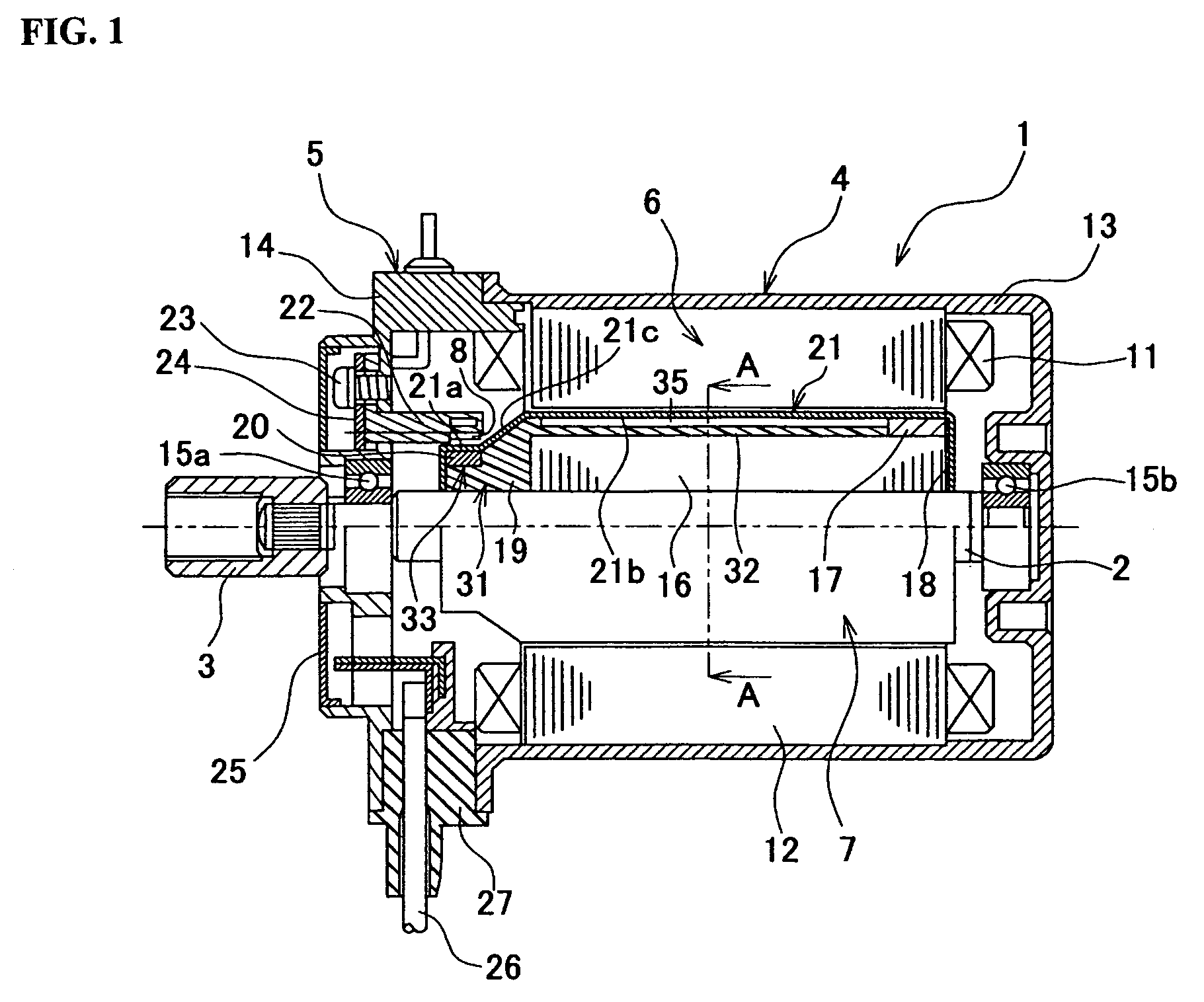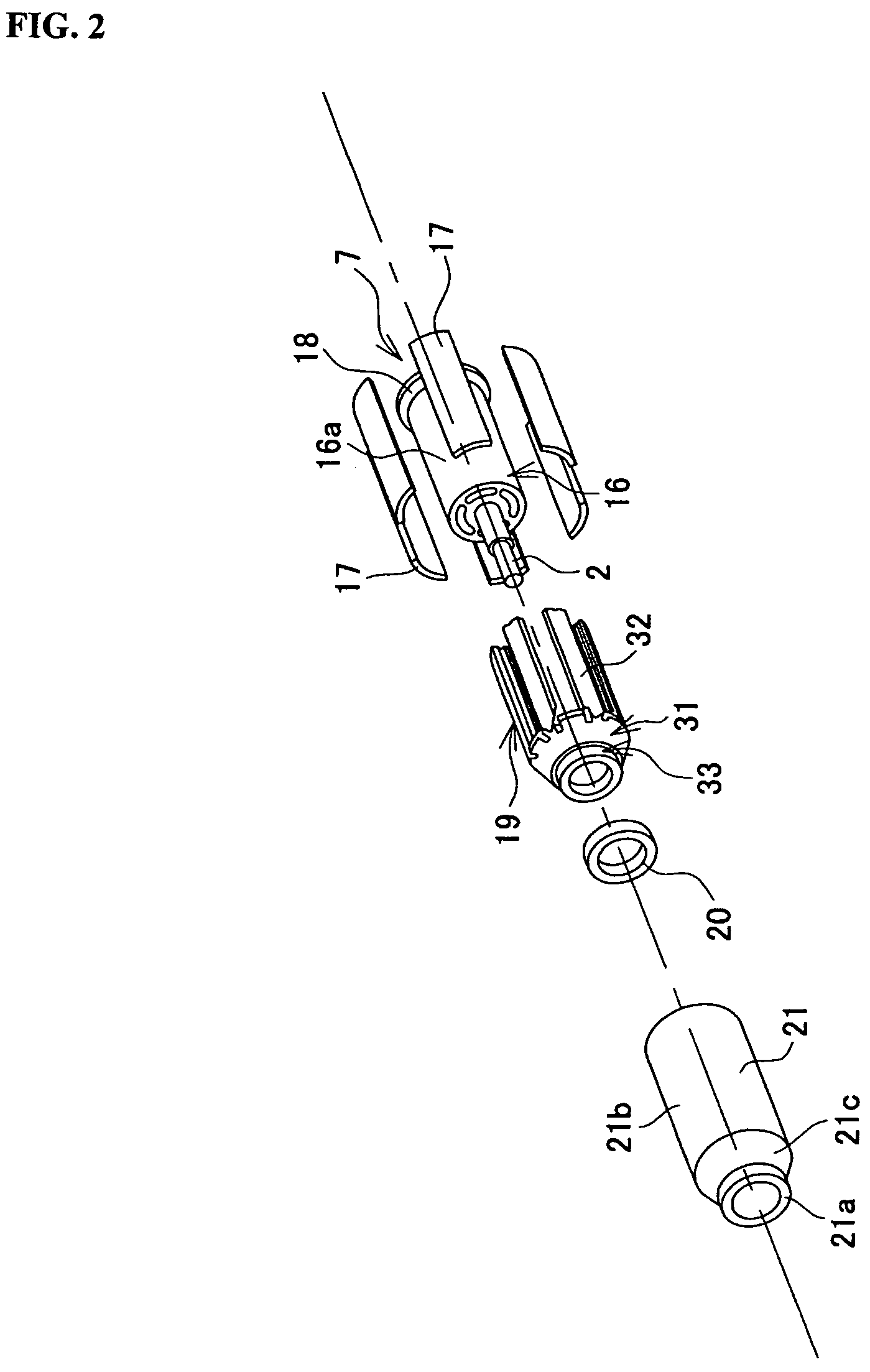Magnet fixing structure for electric rotary machine
a technology of fixing structure and electric rotary machine, which is applied in the direction of dynamo-electric machines, magnetic circuit rotating parts, magnetic circuit shape/form/construction, etc., can solve the problems of difficult to maintain the bonding strength, easy degradation of adhesive agents in hot environments, and broken magnets rigidly held by adhesives, etc., to prevent broken, improve the quality of products, and easy degradation
- Summary
- Abstract
- Description
- Claims
- Application Information
AI Technical Summary
Benefits of technology
Problems solved by technology
Method used
Image
Examples
embodiment 1
[0079]FIG. 1 is a schematic cross sectional view of a brushless motor realized by using Embodiment 1 of a magnet fixing structure according to the present invention. FIG. 2 is an exploded schematic perspective view of the brushless motor of FIG. 1. The brushless motor (to be referred to simply as motor hereinafter) of FIGS. 1 and 2 is to be used as drive source for an EPS. The motor 1 supplies steering assisting power according to the steering angle and the running speed of the vehicle as the driver operates a steering wheel. The rotor shaft (rotary shaft) 2 of the motor 1 is linked to the input shaft of a gear box (not shown) by way of joint 3. The revolutions of the motor 1 are reduced appropriately in the gear box and subsequently transmitted to the steering column of the vehicle so that the steering power of the vehicle is assisted by the rotary power of the motor 1.
[0080]Roughly speaking, the motor 1 comprises a motor section 4 and a sensor section 5. The motor section 4 includ...
embodiment 2
[0100]Embodiment 2 of the present invention differs from Embodiment 1 in that the projections and the grooves of the engagement arrangement of the magnet fixing structure are inverted. FIG. 7 is an enlarged schematic cross sectional view of the second embodiment of a magnet fixing structure according to the present invention. In the following embodiments, the components which are the same as or similar to those of the first embodiment are denoted respectively by the same reference symbols and will not be described further.
[0101]Holder anchoring projections 51 are formed on the outer periphery of the rotor core 16 for the holder anchoring sections of this embodiment. The holder anchoring projections 51 extend along the rotary shaft. A total of six holder anchoring projections 51 are arranged peripherally at regular intervals. The front end part 51a of each of the holder anchoring projections 51 is made broader than the base part 51b thereof. On the other hand, each holder arm 32 has ...
embodiment 3
[0104]Embodiment 3 differs from Embodiment 1 in that the rotor magnets 17 are radially skewed by using a magnet fixing structure similar to that of the first embodiment. FIG. 8 is a schematic cross sectional view of the brushless motor where the rotor magnets are skewed.
[0105]Of the rotor 53 of FIG. 8, the rotor magnets 17 indicated by hatching are skewed to step aside (be offset) in the radial direction between the front half and the rear half thereof. Note that a resolver is used for the rotor 53 as described in the last part of the description of Embodiment 1. Magnet holder 54 is used for the front rotor 53a whereas magnet holder 55 is used for the rear rotor 53b. The magnet holder 54 is realized by axially reducing the length of the holder arms 32 of the magnet holder 19 of Embodiment 1. On the other hand, the magnet holder 55 does not have any holder base 31 of the magnet holder 19. In other words, the magnet holder 55 has only holder arms 32.
[0106]The rotors 53a, 53b are forme...
PUM
 Login to View More
Login to View More Abstract
Description
Claims
Application Information
 Login to View More
Login to View More - R&D
- Intellectual Property
- Life Sciences
- Materials
- Tech Scout
- Unparalleled Data Quality
- Higher Quality Content
- 60% Fewer Hallucinations
Browse by: Latest US Patents, China's latest patents, Technical Efficacy Thesaurus, Application Domain, Technology Topic, Popular Technical Reports.
© 2025 PatSnap. All rights reserved.Legal|Privacy policy|Modern Slavery Act Transparency Statement|Sitemap|About US| Contact US: help@patsnap.com



